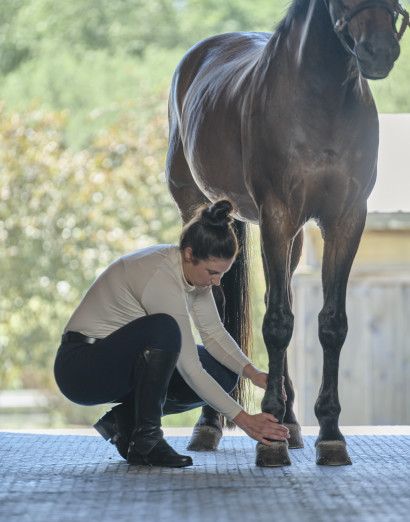Keep a Finger on Your Horse's Digital Pulse
Updated May 2, 2024 | By: Dr. Lydia Gray
"My 6 year old t-bred/paint cross gelding recently had a very mild case of laminitis. We caught it early; my vet gave an initial IV shot of bute and then had me paste bute for 3 days, gradually reducing the dosage. By the next day, my gelding was much better and did not seem to be in pain. We attributed the attack to lush grass. I have begun allowing him very limited access to grass (1-2 hours per day) and he is on a dry lot with hay the rest of the time. I check his digital pulse at the fetlock daily and here-in lies my question:
My vet told me that a “bounding pulse” indicates a problem. I am having a hard time determining what constitutes “bounding”. Sometimes I am able to easily feel the pulse though it does not seem hard or fast. When I have felt the pulse, my horse does not seem to be in pain and is moving freely and easily. Other times I am not able to find the pulse and he seems a bit ouchy. There does not seem to be the correct correlation of pulse intensity to discomfort level! I am assuming that the digital pulse will vary depending on activity, temperature, environment and so on.
Am I over thinking this or should I be concerned that I am finding such variance in the pulse? What is a good way to determine healthy digital pulse versus a digital pulse that raises concern? Does this mild attack preclude my horse from ever being able to graze freely again? Any other suggestions on management of the laminitic horse would be greatly appreciated!"
Thank you!! Best Regards, – L. Vandre

Dear L.,
No, you are not overthinking laminitis—I don’t think that’s possible! There are different theories for why horses develop laminitis, and countless studies going on in research laboratories all over the world. Some of the most helpful diagnostic tests and treatments are the result of owners, veterinarians and farriers making careful observations of laminitic horses, as you are doing. So please, continue checking his pulse, hoof temperature, degree of lameness, attitude and appetite, even his heart and respiratory rate, on a daily basis.
Because you’re also right about things like activity and the environment causing variety in these measurements, try to perform your tests at the same time every day under the same conditions. For example, if your routine is to feed at 7:00am and turnout at 7:30, give him his “checkup” at 7:10 so he’s over the excitement of food but not yet worked up about getting out of his stall.
The challenge is to put all the information you’re collecting together and monitor the trend. I recommend you record your observations in a daily journal, so you can keep your veterinarian and farrier informed of what you’re seeing and perhaps find a pattern of good days and bad days.
Please note that during a bout of laminitis, the blood flow to the horse’s foot is believed to both increase AND decrease, so you may be noticing real changes as the disease improves or progresses.
Now to your other question: will your horse ever be able to graze freely again? To be on the safe side, ask your veterinarian to test your horse for insulin resistance, associated with Equine Metabolic Syndrome (EMS), which predisposes horses to pasture-associated laminitis.
Based on the results of your horse’s blood sugar and insulin levels, your veterinarian will work with you to develop the most appropriate diet, exercise and turnout program for your guy. Be prepared for no grain, light daily workouts and pasture grazing only with a muzzle.
In addition, supplementing with Vitamin E and other antioxidants may be recommended. I’m actually crossing my fingers that your horse is diagnosed with EMS, because then you’ll have an answer as to why he developed laminitis in the first place and also will have some concrete things to do and not do to hopefully prevent it from recurring.